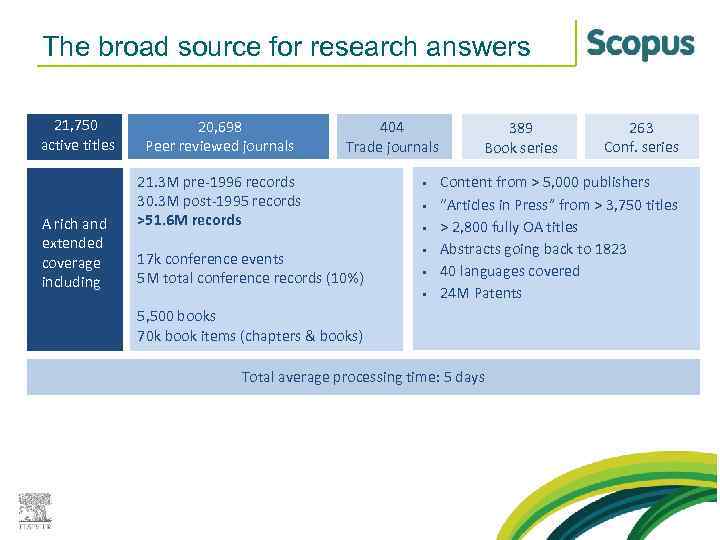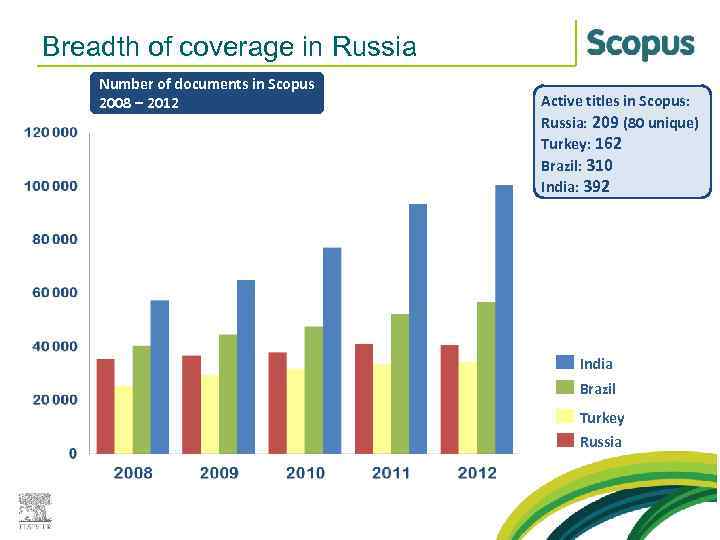Мистер_В_Содержание Scopus.pptx
- Количество слайдов: 36
 SCOPUS CONTENT COVERAGE AND CONTENT SELECTION Dr. Wim Meester Senior Product Manager w. meester@elsevier. com http: //orcid. org/0000 -0001 -9350 -3448
SCOPUS CONTENT COVERAGE AND CONTENT SELECTION Dr. Wim Meester Senior Product Manager w. meester@elsevier. com http: //orcid. org/0000 -0001 -9350 -3448
 Science is growing globally http: //info. scival. com/research-initiatives/science-europe
Science is growing globally http: //info. scival. com/research-initiatives/science-europe
 (International) collaboration is rising
(International) collaboration is rising
 Collaboration increases citation impact
Collaboration increases citation impact
 Citation impact of international collaboration
Citation impact of international collaboration
 • Coverage across engineering subject areas: completeness of coverage, coverage of Engineering Village, coverage pre-1996; coverage non-English material;
• Coverage across engineering subject areas: completeness of coverage, coverage of Engineering Village, coverage pre-1996; coverage non-English material;
 The broad source for research answers 21, 750 active titles A rich and extended coverage including 20, 698 Peer reviewed journals 404 Trade journals 21. 3 M pre-1996 records 30. 3 M post-1995 records >51. 6 M records § 17 k conference events 5 M total conference records (10%) § § § 389 Book series 263 Conf. series Content from > 5, 000 publishers “Articles in Press” from > 3, 750 titles > 2, 800 fully OA titles Abstracts going back to 1823 40 languages covered 24 M Patents 5, 500 books 70 k book items (chapters & books) Total average processing time: 5 days
The broad source for research answers 21, 750 active titles A rich and extended coverage including 20, 698 Peer reviewed journals 404 Trade journals 21. 3 M pre-1996 records 30. 3 M post-1995 records >51. 6 M records § 17 k conference events 5 M total conference records (10%) § § § 389 Book series 263 Conf. series Content from > 5, 000 publishers “Articles in Press” from > 3, 750 titles > 2, 800 fully OA titles Abstracts going back to 1823 40 languages covered 24 M Patents 5, 500 books 70 k book items (chapters & books) Total average processing time: 5 days
 Breadth of coverage across subject areas Physical Sciences 6, 600 Health Sciences 6, 300 Social Sciences 6, 350 Life Sciences 4, 050 • Chemistry • (100% Medline) • Psychology • Neuroscience • Physics • Nursing • Economics • Pharmacology • Engineering • Dentistry • Business • Biology • etc. , • A&H etc. , • etc. , More than 20, 400 titles in Scopus, titles can be in more than one subject area
Breadth of coverage across subject areas Physical Sciences 6, 600 Health Sciences 6, 300 Social Sciences 6, 350 Life Sciences 4, 050 • Chemistry • (100% Medline) • Psychology • Neuroscience • Physics • Nursing • Economics • Pharmacology • Engineering • Dentistry • Business • Biology • etc. , • A&H etc. , • etc. , More than 20, 400 titles in Scopus, titles can be in more than one subject area
 Geographical distribution of titles 0 5, 000 Wider coverage gives a more accurate picture of the research landscape
Geographical distribution of titles 0 5, 000 Wider coverage gives a more accurate picture of the research landscape
 Breadth of coverage in Russia Number of documents in Scopus 2008 – 2012 Active titles in Scopus: Russia: 209 (80 unique) Turkey: 162 Brazil: 310 India: 392 India Brazil Turkey Russia
Breadth of coverage in Russia Number of documents in Scopus 2008 – 2012 Active titles in Scopus: Russia: 209 (80 unique) Turkey: 162 Brazil: 310 India: 392 India Brazil Turkey Russia
 Broader coverage than nearest peer Scopus (Total: 19, 809) Web of Science 8, 432 (Total: 12, 311) 11, 377 934 Scopus Advantage Source: http: //adat. crl. edu/, May 2012
Broader coverage than nearest peer Scopus (Total: 19, 809) Web of Science 8, 432 (Total: 12, 311) 11, 377 934 Scopus Advantage Source: http: //adat. crl. edu/, May 2012
 Broader coverage = higher citations
Broader coverage = higher citations
 • Coverage across engineering subject areas: completeness of coverage, coverage of Engineering Village, coverage pre-1996; coverage non-English material;
• Coverage across engineering subject areas: completeness of coverage, coverage of Engineering Village, coverage pre-1996; coverage non-English material;
 Expansive coverage does not mean lower standards Publisher Suggest title Independent Content Selection & Advisory Board (CSAB) Check minimum criteria Select titles based on quality Titles processed via the online Scopus Title Evaluation Platform (STEP) Focus on quality through selection by independent CSAB to: • Provide accurate and relevant search results for users • No dilution of search results by irrelevant or low quality content • Support that Scopus is recognized as authoritative • Support confidence that Scopus is “reflecting the truth” • Assurance that titles selected by Scopus meet the highest (ethical) standards
Expansive coverage does not mean lower standards Publisher Suggest title Independent Content Selection & Advisory Board (CSAB) Check minimum criteria Select titles based on quality Titles processed via the online Scopus Title Evaluation Platform (STEP) Focus on quality through selection by independent CSAB to: • Provide accurate and relevant search results for users • No dilution of search results by irrelevant or low quality content • Support that Scopus is recognized as authoritative • Support confidence that Scopus is “reflecting the truth” • Assurance that titles selected by Scopus meet the highest (ethical) standards
 Scopus selection criteria Journal policy Minimum criteria • • • Peer-review English abstracts Quality of content Regular publication References in Roman script Publication ethics statement Journal standing Regularity Online availability • • • • Convincing editorial concept/policy Level of peer-review Diversity in geographic distribution of editors Diversity in geographic distribution of authors Academic contribution to the field Clarity of abstracts Quality and conformity with stated aims & scope Readability of articles Citedness of journal articles in Scopus Editor standing No delay in publication schedule Content available online English-language journal home page Quality of home page
Scopus selection criteria Journal policy Minimum criteria • • • Peer-review English abstracts Quality of content Regular publication References in Roman script Publication ethics statement Journal standing Regularity Online availability • • • • Convincing editorial concept/policy Level of peer-review Diversity in geographic distribution of editors Diversity in geographic distribution of authors Academic contribution to the field Clarity of abstracts Quality and conformity with stated aims & scope Readability of articles Citedness of journal articles in Scopus Editor standing No delay in publication schedule Content available online English-language journal home page Quality of home page
 Title suggestions per country All title suggestions received in 2012 2, 820 titles suggested in 2012 of which 1, 020 acceptable for review
Title suggestions per country All title suggestions received in 2012 2, 820 titles suggested in 2012 of which 1, 020 acceptable for review
 Titles reviewed Acceptance rate Number of titles reviewed (n=2, 976, January 2011 – December 2012) 2012: Total 1, 271 titles reviewed of which 47% accepted
Titles reviewed Acceptance rate Number of titles reviewed (n=2, 976, January 2011 – December 2012) 2012: Total 1, 271 titles reviewed of which 47% accepted
 Titles reviewed top 25 countries (2012) Accepted Rejected
Titles reviewed top 25 countries (2012) Accepted Rejected
 • Coverage across engineering subject areas: completeness of coverage, coverage of Engineering Village, coverage pre-1996; coverage non-English material; titlesuggestion@scopus. com
• Coverage across engineering subject areas: completeness of coverage, coverage of Engineering Village, coverage pre-1996; coverage non-English material; titlesuggestion@scopus. com
 Which metric to use? 1. What level am I assessing? • Article, Journal, Researcher, Institution, etc. 2. What type of impact am I assessing? • Scientific, Clinical, Societal, Educational, etc. 3. What methods are available based on above? • Quantitative: citation, usage, media, h-index, SNIP, SJR, etc. • Qualitative: Peer-review, etc. Bibliometrics (quantitative measures used to asses research output) Basic premise = Citation is a form of endorsement Bibliometricians agree that no single metric can effectively capture the entire spectrum of research performance because no single metric can address all key variables
Which metric to use? 1. What level am I assessing? • Article, Journal, Researcher, Institution, etc. 2. What type of impact am I assessing? • Scientific, Clinical, Societal, Educational, etc. 3. What methods are available based on above? • Quantitative: citation, usage, media, h-index, SNIP, SJR, etc. • Qualitative: Peer-review, etc. Bibliometrics (quantitative measures used to asses research output) Basic premise = Citation is a form of endorsement Bibliometricians agree that no single metric can effectively capture the entire spectrum of research performance because no single metric can address all key variables
 Journal Impact Factor Which journal is best? Journal Impact Factor 2008* Lancet Infectious Diseases 13. 165 Social Studies of Science 1. 343 Dyes & Pigments 2. 507 Expert Systems with Applications 2. 596 Progress in Nuclear Magnetic Resonance Spectroscopy 6. 162 Communications on Pure & Applied Mathematics 3. 806 *Journal Citation Reports 2009 They are all the best – all the top of their subject categories
Journal Impact Factor Which journal is best? Journal Impact Factor 2008* Lancet Infectious Diseases 13. 165 Social Studies of Science 1. 343 Dyes & Pigments 2. 507 Expert Systems with Applications 2. 596 Progress in Nuclear Magnetic Resonance Spectroscopy 6. 162 Communications on Pure & Applied Mathematics 3. 806 *Journal Citation Reports 2009 They are all the best – all the top of their subject categories
![Journal Impact Factor “[Publishers should] Greatly reduce emphasis on the journal impact factor as Journal Impact Factor “[Publishers should] Greatly reduce emphasis on the journal impact factor as](https://present5.com/presentation/1/137159705_230908047.pdf-img/137159705_230908047.pdf-22.jpg) Journal Impact Factor “[Publishers should] Greatly reduce emphasis on the journal impact factor as a promotional tool ideally by ceasing to promote the impact factor or by presenting the metrics in the context of a variety of journal based metrics … that provide a richer view of journal performance” Vanclay, J, Impact factor: outdated artefact or stepping-stone to journal certification, Scientometrics, Volume 92, Issue 2 (August 2012) - From The San Francisco Declaration on Research Assessment (DORA) http: //am. ascb. org/dora/
Journal Impact Factor “[Publishers should] Greatly reduce emphasis on the journal impact factor as a promotional tool ideally by ceasing to promote the impact factor or by presenting the metrics in the context of a variety of journal based metrics … that provide a richer view of journal performance” Vanclay, J, Impact factor: outdated artefact or stepping-stone to journal certification, Scientometrics, Volume 92, Issue 2 (August 2012) - From The San Francisco Declaration on Research Assessment (DORA) http: //am. ascb. org/dora/
 More accuracy, transparency, more metrics www. journalmetrics. com
More accuracy, transparency, more metrics www. journalmetrics. com
 SNIP: Source-normalized impact per paper A journal’s raw impact per paper + + + Citation potential in its subject field A field’s frequency and immediacy of citation Database coverage Journal’s scope and focus Peer reviewed papers only Measured relative to database median
SNIP: Source-normalized impact per paper A journal’s raw impact per paper + + + Citation potential in its subject field A field’s frequency and immediacy of citation Database coverage Journal’s scope and focus Peer reviewed papers only Measured relative to database median
 SNIP: Molecular Biology VS Mathematics Journal RIP Cit. Pot. SNIP (RIP/Cit. Pot. ) Inventiones Mathematicae 1. 5 0. 4 3. 8 Molecular Cell 13. 0 3. 2 4. 0
SNIP: Molecular Biology VS Mathematics Journal RIP Cit. Pot. SNIP (RIP/Cit. Pot. ) Inventiones Mathematicae 1. 5 0. 4 3. 8 Molecular Cell 13. 0 3. 2 4. 0
 SJR: SCImago Journal Rank Prestige metric: Prestige transferred when a journal cites • Citations are weighted depending on where they come from • A journal’s prestige is shared equally between its citations Life Sciences journal Arts & Humanities journal High impact, lots of citations One citation = low value Low impact, few on citations One citation = high value SJR normalizes for differences in citation behaviour between subject fields
SJR: SCImago Journal Rank Prestige metric: Prestige transferred when a journal cites • Citations are weighted depending on where they come from • A journal’s prestige is shared equally between its citations Life Sciences journal Arts & Humanities journal High impact, lots of citations One citation = low value Low impact, few on citations One citation = high value SJR normalizes for differences in citation behaviour between subject fields
 More analysis using Scopus: Journal Analyzer
More analysis using Scopus: Journal Analyzer
 APIs to promote journal prestige
APIs to promote journal prestige
 APIs to promote article-level metrics
APIs to promote article-level metrics
 Societal impact and media mentions via Altmetric for Scopus
Societal impact and media mentions via Altmetric for Scopus

 Books expansion initiative Journals • Timely • Formal • Peer-reviewed Conferences • New ideas • Preliminary research • Bit less formal Books • In depth analysis • Formal (editorial) review Further benefits: • Improve Arts & Humanities coverage in Scopus • Enhance discoverability of books and book content • Measure the impact of books • Increase accuracy of Author Profiles
Books expansion initiative Journals • Timely • Formal • Peer-reviewed Conferences • New ideas • Preliminary research • Bit less formal Books • In depth analysis • Formal (editorial) review Further benefits: • Improve Arts & Humanities coverage in Scopus • Enhance discoverability of books and book content • Measure the impact of books • Increase accuracy of Author Profiles
 Scope and selection of books expansion Will cover scholarly books that represent fully-referenced, original research or literature reviews. Subject areas Coverage years • Social sciences and Arts & Humanities, also Science, Technology & Medicine (STM) • Back to 2005 (2003 for A&H) Number of books • 75, 000 over three years (25, 000 by year end 2013); 10, 000 each year thereafter Book types • Monographs, edited volumes, graduate level text books, major reference works Not in scope • Dissertations, undergraduate level text books, Atlas, Yearbook, Biography, Popular science books, manuals Book selection via a publisherbased approach (no suggestions). All books from selected publishers deemed “in scope” will be selected for coverage. Selection depends on: § Reputation and impact of the publisher § Size and subject area of the books list § Availability and format of the book content § Publication policy and editorial mission § Quality of published book content
Scope and selection of books expansion Will cover scholarly books that represent fully-referenced, original research or literature reviews. Subject areas Coverage years • Social sciences and Arts & Humanities, also Science, Technology & Medicine (STM) • Back to 2005 (2003 for A&H) Number of books • 75, 000 over three years (25, 000 by year end 2013); 10, 000 each year thereafter Book types • Monographs, edited volumes, graduate level text books, major reference works Not in scope • Dissertations, undergraduate level text books, Atlas, Yearbook, Biography, Popular science books, manuals Book selection via a publisherbased approach (no suggestions). All books from selected publishers deemed “in scope” will be selected for coverage. Selection depends on: § Reputation and impact of the publisher § Size and subject area of the books list § Availability and format of the book content § Publication policy and editorial mission § Quality of published book content


 SPASIBO! спасибо
SPASIBO! спасибо


